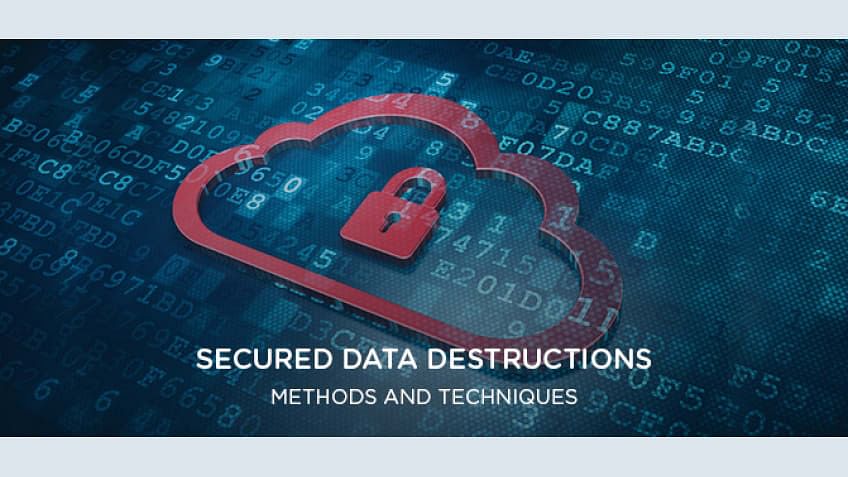The Relevance of Effective Data Damage Practices in Shielding Sensitive Info and Ensuring Computer Safety
In a period where information violations are progressively typical, the relevance of reliable information devastation techniques can not be overstated. Organizations face significant risks when sensitive info is improperly thrown away, possibly causing unauthorized gain access to and serious financial consequences. Applying robust information damage methods not just alleviates these dangers yet likewise lines up with legal conformity demands, ensuring that companies maintain their track record and foster customer depend on. The inquiry stays: what details approaches can be used to improve these practices, and just how can organizations properly integrate them right into their overall cybersecurity framework?
Understanding Data Damage
Recognizing data devastation is critical in today's digital landscape, where sensitive info can conveniently be jeopardized. Reliable information damage entails not merely deleting data yet ensuring that data is irretrievable through detailed methods. This process is essential for organizations that manage personal customer info, copyright, or interior records, as any kind of violation can cause extreme economic and reputational effects.
Information damage incorporates different methods, consisting of shredding physical media, degaussing magnetic storage space tools, and utilizing software-based options that overwrite information several times. Each method serves a particular purpose and has to align with the level of sensitivity of the details being thrown away. For instance, physical damage is usually liked for hard disks including highly personal data, while software program approaches might suffice for less delicate info.
Additionally, adhering to sector standards and policies, such as the General Data Security Regulation (GDPR) or the Health And Wellness Insurance Mobility and Accountability Act (HIPAA), is essential for conformity and to alleviate lawful risks. Organizations needs to develop a robust data devastation policy, train employees on ideal methods, and on a regular basis audit their treatments to guarantee that all delicate info is thrown away safely and successfully.
Dangers of Inadequate Practices
Insufficient data devastation techniques expose organizations to significant threats that can have far-ranging consequences. When sensitive details is not properly taken care of, it continues to be vulnerable to unauthorized gain access to, which can cause information violations and identity burglary. Such occurrences not just endanger the protection of people but likewise taint the company's credibility, causing a loss of customer trust and potential financial repercussions.
Furthermore, regulatory compliance is increasingly stringent in many sectors. Failing to stick to information devastation guidelines can lead to large penalties and lawsuits against companies. These penalties can draw away and stress monetary resources interest from core organization operations.
Furthermore, the abuse of recurring information can bring about intellectual property burglary or business reconnaissance, jeopardizing affordable advantages (data destruction). The effect of insufficient data devastation prolongs beyond instant financial losses; it can additionally result in lasting damage to brand honesty and market setting

Organizations should identify that data safety and security is not solely regarding avoiding breaches; it additionally includes the responsible management of information throughout its lifecycle. Neglecting effective information destruction procedures can have tragic ramifications, emphasizing the necessity for robust actions to mitigate these risks.
Ideal Practices for Information Devastation
Executing reliable information damage practices is necessary for protecting delicate information and preserving conformity with governing criteria. Organizations should embrace a multi-faceted strategy to ensure that data is irretrievable, consequently avoiding unapproved accessibility and potential breaches.
First, data need to be categorized based upon level of sensitivity, allowing companies to use ideal devastation techniques tailored to the level of threat. For digital data, utilizing software-based data-wiping tools that abide by sector standards can properly overwrite existing information. Physical destruction methods, such as shredding or degaussing, are important for gadgets that save sensitive details, making certain total obliteration.
Developing a clear information retention plan is essential, detailing the length of time different kinds of info need to be retained before damage. Regular audits of data storage space systems are additionally essential to recognize obsolete or unneeded information requiring elimination.
Furthermore, training workers on the significance of data destruction and the particular procedures to follow fosters a culture of safety within the company. Finally, keeping documentation of data damage refines provides responsibility and supports conformity with outside laws and inner plans. By adhering to these best techniques, organizations can dramatically reduce the dangers related to information exposure.
Legal and Compliance Factors To Consider

Failure to adhere to these laws can result in severe fines, consisting of substantial fines and reputational damage. Organizations needs to carry out a durable information destruction policy that aligns with these lawful structures and offers clear guidelines on the proper approaches of information disposal, whether physical shredding or digital cleaning.
Additionally, preserving paperwork of data damage activities is necessary for showing conformity during audits or examinations. By focusing on legal and compliance considerations, organizations can enhance their data safety and security posture and foster trust with stakeholders and customers, eventually contributing to a more protected data monitoring atmosphere.
Benefits of Effective Information Devastation
Efficient data devastation methods extend past simple conformity; they use considerable benefits to organizations that prioritize them. By making sure that sensitive details is irretrievably ruined, companies alleviate the risk of information breaches and the possible financial effects connected with them. This proactive technique not only safeguards versus unauthorized access however also improves the overall credibility of the company in the eyes of customers and stakeholders.
Executing durable information destruction approaches, such as physical devastation of storage space devices or advanced information wiping methods, contributes to the fortifying of an organization's cybersecurity stance. data destruction. It reduces the likelihood of intellectual building theft and secures proprietary details, thus keeping an one-upmanship in the market

Verdict
In conclusion, effective data destruction practices are essential for protecting sensitive info and boosting total computer system security. Eventually, a commitment to robust data destruction strategies fosters a society of duty, therefore reinforcing an organization's cybersecurity stance and maintaining client trust fund.
